How to treat ingrown nail?
Ingrown nail is a common condition occurs when a nail pierces the lateral nail fold of finger or toe nails and enters the dermis where it is considered as a foreign body as a result granulation tissue grows on the nail plate. The big toe is affected in the vast majority of cases.
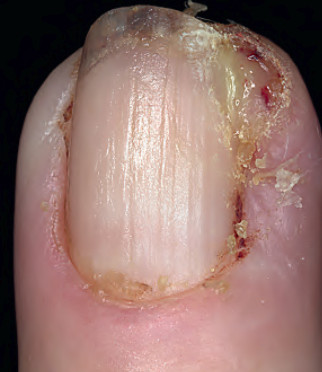
Synonyms
- Onychocryptosis.
- Unguis incarnates.
Presentation
- Pain
- Swelling
- Redness
- bacterial infection.
- Pus formation
- Formation of granulation tissue.
Ingrown nail staging
- Stage I (mild): nail fold swelling, edema, erythema, and pain increasing by pressure.
- Stage II (Moderate): Stage I features plus an active or acute infection. Presents as granulation tissue, seropurulent discharge, or ulceration of the nail fold.
- Stage III (Severe): chronic inflammation with formation of epithelialized granulation tissue with marked nail fold hypertrophy.
Treatment options of ingrown nail
- Elimination of the risk factors
- wearing comfortable shoes.
- Avoid improper nail cutting.
- Avoid trauma.
- Obesity management.
- Hyperhidrosis management.
- Exclude drug induced ingrown nail.
Proper nail cutting technique education
Patients are advised to trim toenails by cutting straight across the nail plate without rounding the edges.
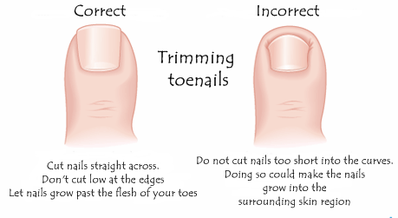
- Warm water soaks: 10 to 20 minutes twice daily soaking of the affected nail in warm, soapy water may relieve the pain. Topical antiseptics may be applied after that to decrease inflammation and bacterial infection.
- Topical application of topical antibiotics combined to topical corticosteroids may reduce inflammation.
- Systemic antibiotic for severe infection or cellulitis.
- Topical silver nitrate applied to the granulation tissue may decrease the inflammation.
- Potent topical corticosteroids can help to diminish inflammation and suppress granulation tissue after infection has been managed.
- Suspected lesions should be biopsied and a melanotic melanoma must not be missed.
Conservative Treatments (For Stage I)
- Taping :a 4 cm long adhesive tape on the edge of the affected fold and pulling it continuously away from the nail edge by turning the tape around the toe. It should be changed at least once daily to keep the traction continuous.

- Cotton Insertion : Applying a piece of cotton wool under the corner of the nail can provide good results with variable recurrence rates. It should be repeated daily.
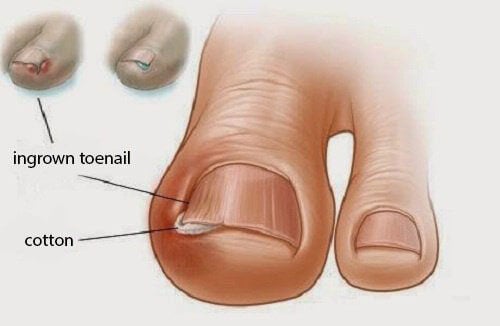
- Dental floss technique
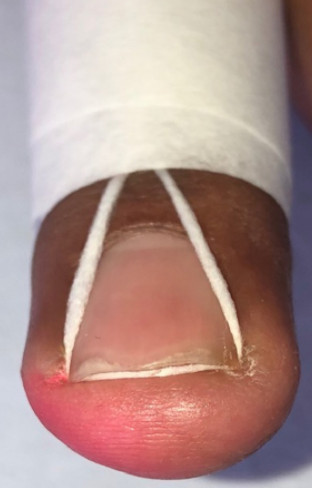
- Gutter technique : a sterile plastic tube (a vinyl intravenous drip infusion tube) is used to separate the lateral nail fold from the nail plate. For more details. CLick here
- Orthonyxia : It aims to correct toenail curvature. It is commonly referred as nail bracing. There are two types : adhesive and hooked. Adhesive brace is safe and effective.
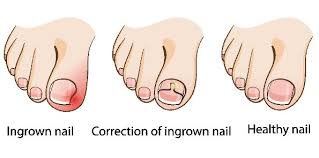
- Nail wiring
Surgical treatment options
- Mechanical partial matricectomy :excising the affected portion of the nail.
- Chemical partial matricectomy (less recurrence) : After applying a tourniquet, the lateral part of the nail (3–5 mm width) is avulsed to its most proximal end, to unveil the matrix. Then the chemical cauterant, which can be phenol (80%–90%) can be safely used in children and diabetic patients, sodium hydroxide (10-20%), or trichloroacetic acid (100%), is applied for a determined time. The phenol matrixectomy remains the most common surgical procedure done today for permanent correction of ingrown nail.
- Soft-tissue nail fold excision technique: consists of excision of the soft tissue not the nail plate.
- CO2 laser matricectomy : with a success rate of 50–100%.
- Cryosurgery is an excellent option that avoids the need for conventional nail surgery. It may also be used after partial nail removal.
- Electrocautery: partial matrixectomy can be performed using electrocautery after partial nail extraction.
References
- https://onlinelibrary.wiley.com/doi/full/10.1111/ijd.14769#ijd14769-fig-0006
- https://www.ncbi.nlm.nih.gov/books/NBK546697/
- https://onlinelibrary.wiley.com/doi/epdf/10.1111/dsu.12068.
#How to treat ingrown nail
Thanks